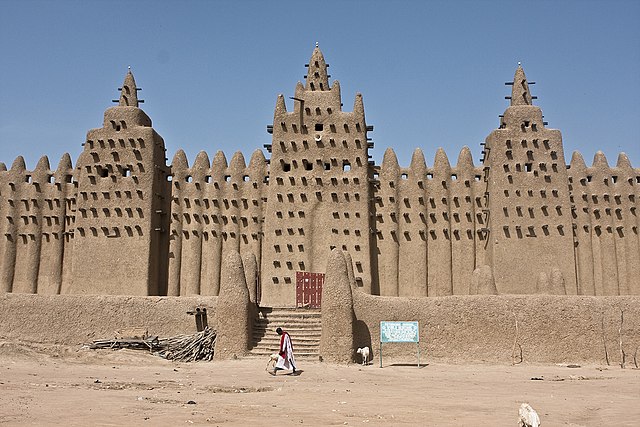
Why Visit Mali?
Mali, a gem of West Africa, is known for its rich cultural heritage, ancient civilizations, and breathtaking landscapes. From the legendary city of Timbuktu to the stunning cliffs of Bandiagara, Mali offers a unique blend of history, art, and adventure. Whether you’re exploring vibrant markets, learning about Mali’s musical traditions, or marveling at its UNESCO World Heritage Sites, this destination promises an unforgettable experience.
Famous Places to Visit in Mali
Timbuktu: The fabled city of gold, known for its historic mosques and ancient manuscripts.
Djenne: Famous for its stunning Great Mosque, the largest mud-brick structure in the world.
Bandiagara Escarpment: A UNESCO World Heritage Site and home to the fascinating Dogon culture.
Mopti: Known as the “Venice of Mali,” this river port town offers boat rides on the Niger River.
Segou: Experience traditional crafts, colonial architecture, and cultural festivals.
Sikasso: A lush region with scenic landscapes, waterfalls, and ancient ruins.
National Museum of Mali (Bamako): Discover artifacts and exhibits showcasing Mali’s rich history.
Tour Highlights
Historical Landmarks: Explore ancient mosques, Saharan trading centers, and archaeological sites.
Cultural Immersion: Witness the unique traditions, dances, and art of the Dogon people.
River Adventures: Cruise along the Niger River, passing through picturesque villages and markets.
Natural Wonders: Marvel at the dramatic Bandiagara cliffs and lush green landscapes in Sikasso.
Music and Festivals: Enjoy the sounds of traditional Malian music and participate in vibrant local festivals.
Helpful Tips for Visitors
Best Time to Visit:
November to February: Cool and dry weather, ideal for sightseeing.
Avoid May to October due to the rainy season and high humidity.
Currency: West African CFA Franc (XOF). Cash is commonly used; credit cards are rarely accepted.
Language: French is the official language, but Bambara and other local dialects are widely spoken.
Packing Essentials: Lightweight, breathable clothing and comfortable walking shoes.
A hat, sunglasses, and sunscreen to protect against the sun.
A reusable water bottle and insect repellent.
Health Precautions: Consult a doctor about recommended vaccinations (e.g., yellow fever).
Drink bottled or filtered water and avoid uncooked street food.
Respect Local Customs: Dress modestly, especially in rural and religious areas.
Seek permission before photographing people or cultural sites.
Day 1: Arrival in Bamako
Arrival: Land at Modibo Keita International Airport in Bamako.
Activities: Visit the National Museum of Mali to learn about the country’s history and culture.
Explore the bustling Bamako Market and vibrant artisan workshops.
Stroll along the Niger River and enjoy the sunset.
Evening: Dinner at a local restaurant with traditional Malian dishes like tigadèguèna (peanut stew).
Overnight Stay: Bamako.
Day 2: Bamako to Segou
Morning: Drive to Segou (4 hours).
Activities: Walk through Segou’s colonial-era streets and admire its French-inspired architecture.
Visit the Kalabougou Pottery Village, where artisans craft traditional pottery.
Enjoy a Niger River cruise, observing local life and stunning landscapes.
Overnight Stay: Segou.
Day 3: Segou to Djenné
Morning: Depart for Djenné (6-hour drive).
Activities: Explore the Great Mosque of Djenné, the largest mud-brick building in the world and a UNESCO World Heritage Site.
Visit the vibrant Monday Market, a hub of local trade and culture.
Stroll through Djenné’s historic streets, discovering its ancient architecture.
Overnight Stay: Djenné.
Day 4: Djenné to Mopti
Morning: Travel to Mopti (2 hours).
Activities: Explore Mopti, known as the “Venice of Mali,” with its canals and bustling harbor.
Visit the Grand Mosque of Mopti and the local fish market.
Take a boat ride on the Niger River to see local villages and life along the riverbanks.
Overnight Stay: Mopti.
Day 5: Mopti to Dogon Country
Morning: Drive to Dogon Country (3 hours).
Activities: Begin exploring Dogon villages, known for their unique culture and cliffside architecture.
Visit Bandiagara Escarpment, a UNESCO World Heritage Site, and marvel at the ancient cliff dwellings.
Learn about the Dogon people’s traditions and customs.
Overnight Stay: A guesthouse in Dogon Country.
Day 6: Dogon Country Exploration
Activities: Take a guided trek through Dogon villages like Teli and Sanga, observing their unique granaries, homes, and sacred sites.
Participate in a traditional Dogon dance or ceremony (subject to availability).
Enjoy panoramic views of the escarpment and surrounding plains.
Overnight Stay: Dogon Country.
Day 7: Return to Bamako
Morning: Drive back to Bamako (8-9 hours).
Activities: Relax and shop for souvenirs at Bamako’s artisan market.
Visit the Point G Hill for panoramic views of the city.
Evening: Enjoy a farewell dinner with live Malian music at a local venue.
Departure: Transfer to the airport for your flight home or extend your stay.
Travel Tips:
Best Time to Visit: November to February (cool and dry season).
Transportation: Private vehicle with a local guide for safety and navigation.
Packing Essentials: Comfortable clothing, sturdy shoes for trekking, sunscreen, and a hat.
Cultural Etiquette: Respect local customs, especially in religious sites and villages.
Office #302, 3rd Floor, Amer Center Building, Opposite Day Star, Bur Dubai, Dubai, UAE.
info@roohaljamaltravel.com
sales@roohaljamaltravel.com
hr@roohaljamaltravel.com
Phone: +971 4 553 7086
Mon - Sun: 09:00 – 20:00
WhatsApp us